#nycbento
Explore tagged Tumblr posts
Text

I'm pretty good on not rolling or pleating another dumpling for a few weeks. Or months.
33 notes
·
View notes
Text
nycbento replied to your post: Thursday night bento menu, which I can hopefully...
Two things that hold up well in a bento are either to glaze the chicken with soy sauce/mirin or (and this alternative holds up the best) marinate the chicken thigh or breast in miso thinned with a little sake and bake it for about 20 minutes.
Thank you for the info! I’ve decided to marinate the chicken overnight and then pan fry it when I wake up (with a bit less soy sauce as advised by Just Hungry’s Makiko Itoh) so I made the roast veg tonight instead so I don’t end up rushing like the last time. @_@
0 notes
Text
So a few days ago, @nycbento made a lovely bento lunch for himself and me and the kid, and the three of us had a delightful picnic together in Upper Manhattan. Then at the end of the meal, he told us we could keep the bento boxes!! This is the first toddler lunch I made in the new box, for a picnic in the Jumel Mansion's sunken garden yesterday. I should have taken the picture before we left, because the chickpeas got all jumbled up with the cashews and the parmesan went everywhere. Also I maybe should have used some radish or paprika to add a dash of red to the meal. But I'm still pretty pleased with it, considering that it was basically a five-minute speed bento. Many thanks again to @nycbento for the box, the food, the company, and the inspiration!

5 notes
·
View notes
Text

I was flying to Florida last Thursday to give a talk (another part of life being busy in good ways) and I had just enough leftovers from the Balanchine Bento to pack a meal for the plane.
30 notes
·
View notes
Text


Dumpling night part 3: Pelmeni dough fall in the middle of this trio of dumplings from Eastern Europe/Caucasus (Pierogi are Polish, Khinkali are Georgian, Pelmeni are Russian-Siberian). The dough is leaner than Pierogi dough (no egg or sour cream) but not as hard as Khinkali (which is nothing but flour, salt and just enough water to bring the dough together). Pelmeni dough adds enough oil to enable the dough to be rolled thinner. The Siberian version might have things such as bear meat - this version has mushrooms. I used a simple filling of chopped mushrooms (cremini with some dried porcini and shiitake) and onion, all sauteed. I've added pine nuts previously; I don't think it adds enough to the dish to warrant it. I did add a little grated parmesan - I would do that or a bit of nutritional yeast, just enough to add a salty kick. The dough behaves enough that the kids could help again. They did the first roll, I finished it off, cut and shaped. These get served much like pierogi (boil, serve with sour cream and butter).
17 notes
·
View notes
Text

I posted this recipe a while back, but just as a reminder, my biscuit recipe is really good.
13 notes
·
View notes
Text

From Chanukah. You can absolutely make latkes if you're single - this is made with two small potatoes, half an onion and half an egg (the other half went into waffles, I think). Serious Eats had a few great suggestions - there's no need to peel the potatoes, just wash them. Also, after you wring out the liquid from the potatoes, let that water settle for about five minutes. Pour away the brown liquid on top and toss the white potato starch back into the latke mix. It is a great binder. Because I never eat it except when I'm making latkes, I buy applesauce in individual cups.
17 notes
·
View notes
Text
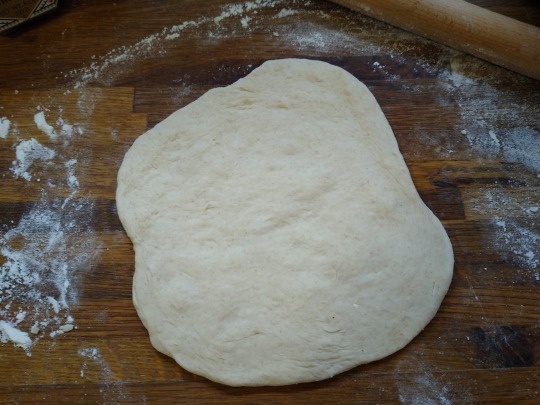
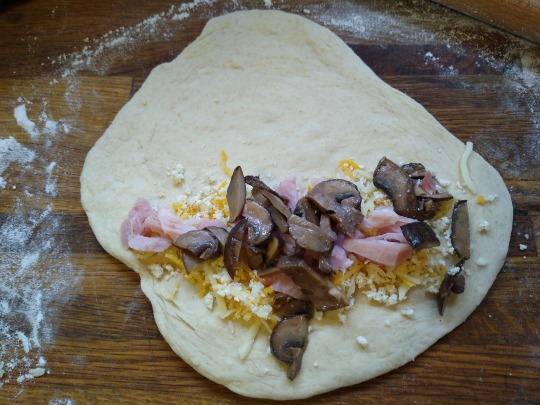
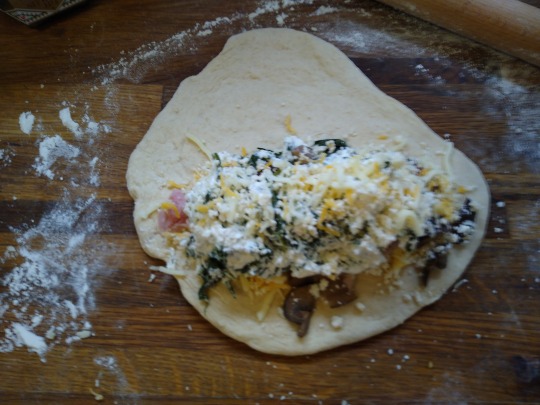
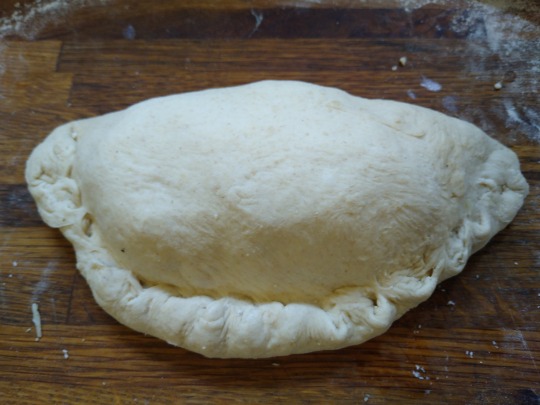

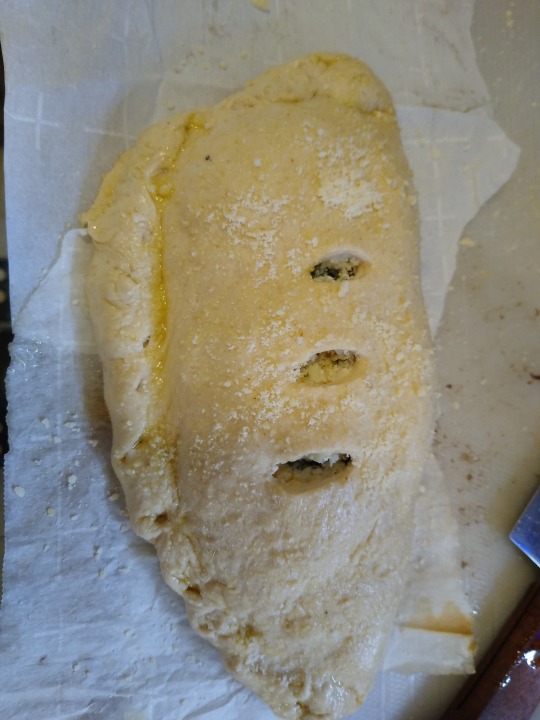
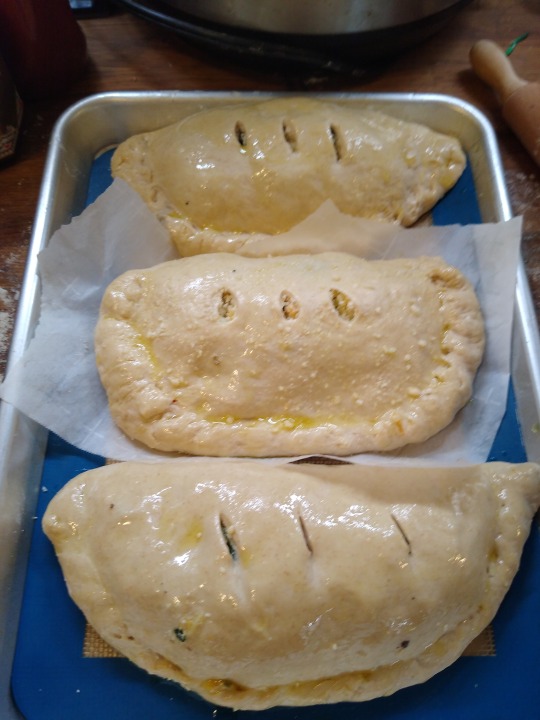

Baking skills are social skills!
I had planned to make calzones (Italian hand pies made with pizza dough) on New Year's Day. I made the dough two days before and left it to proof in the fridge (pizza dough loves long, cold fermentation).
Once I had the dough, the rest was a kind of provident disposal process: This leftover ricotta, that leftover spinach, these remnants of grated cheeses, those leftover mushrooms and a package of ham bits (sung to "partriiiiidge in a pair tree").
I put the ricotta and spinach in strainers - I saved the exuded liquid because I've discovered new doughs love that stuff in the levain. The grated cheese got picked through and combined, the ham and mushroom got chopped in smaller pieces, the spinach got chopped and mixed with the ricotta, adding salt, pepper, Aleppo pepper and a few scrapes of nutmeg, because dairy loves nutmeg like carrots love ginger.
In the interim I started up a simple marinara for dipping (canned tomatoes and one leftover fresh chopped plum tomato simmered in a bit of olive oil with garlic, tomato paste, Calabrian chili peppers for a little kick and herbs)
Each dough bit was about 190 g, on a lightly floured surface (the dough is moist), I patted and rolled it to about the size of a medium plate (8-9"). On one half, lay down melty cheese, then ham and mushroom, ricotta/spinach, then more melty cheese.
Fold over and close up (I did it with the same edging as I'd use for empanadas)
At this point my upstairs neighbor texted - I had asked him if he wanted a black and white cookie, now I offered a calzone as well. He was with his girlfriend, so it became a feast and ego boost - she is on a keto diet, but my baking (particularly pretzels) is her cheat.
Though Chef John at Food Wishes specified an egg wash, that doesn't square with anything I've seen in a pizzeria, so I snipped three vents with kitchen shears, brushing the calzone with olive oil and dusted with a last leftover bit of grana padano cheese.
I put these plump babies on parchment to control spills (and it made them a LOT easier to transfer). Baking was less time than I thought, (about 20 minutes at 450 F until the crust browned and I saw the filling bubble through the vents) I let them cool for at least 45 minutes to set the filling, and then rewarmed then in a low oven before serving.
I thought some of the cheese (particularly the last of the Cotija) was a tiny bit funky in the filling, but my friends loved it. The dipping sauce was perfect with it.
So my baking turned into a nice little New Year's Day party.
12 notes
·
View notes
Photo

My market had ground pork on sale. This innocent item set off a chain reaction of dumplings in my kitchen. Having frozen dumpling wrappers threw gasoline on the fire.
I made the gyoza yesterday. Commercial wrappers are quite inexpensive, reliable and shave several hours off the process. They have a familiar texture and taste, if less character than homemade, but they're worth keeping in the freezer.
I've never made siu mai before, but it uses the same wrappers - in fact both recipes used all filling and wrappers up with no waste. They're easier to form once you get the hang of it, though it does take getting the hang of it.
I had made the pork bun a while back, so it defrosted while I was filling the siu mai and there it was - homemade dim sum at home for brunch!
39 notes
·
View notes
Text





Dumpling night part 2:
Khinkali have a very low hydration dough, similar to Japanese noodles. The reason for this stiff, low moisture, high protein, low fat dough is to create a strong watertight casing for a loose, wet meat filling. Like Chinese soup dumplings, you add liquid to ground meat to create "soup" - I stole the Chinese technique of using jellied pork stock (The Georgians usually use water).
The dough is a pain to knead, but the recommendations to do low hydration doughs, such as noodles, in a food processor, works. A stand mixer doesn't fully incorporate the liquid without you stopping the machine and scraping and kneading the bowl. A dough mixer does a bit better, but a food processor (with the dough hook, not the metal one) does it best: run the water in a thin stream through the feed tube while pulsing. I may try this approach for another low hydration dough: bagels.
This dough takes too much elbow grease for the kids so their mother and I sat at the dining room table and made them - she got each dough ball into a thin disc, I got them thin to the right diameter and shaped.
The last time I made these a friend who had eaten these in Georgia told me the way they ate them, which is easier than the Chinese way of balancing in your ladle and poking a hole in them with a chopstick. These dumplings are sturdy enough to hold by the topknot upside-down, bite a delicate hole in the bottom rim and suck out the soup.
16 notes
·
View notes
Text




If the overexplanation in my bread recipes has convinced you that breadmaking is way too much time and trouble, this one is for you. This focaccia is fun and simple to make. There’s no kneading involved, but some patience as you let an overnight (or longer) rest in the fridge do the work for you. You can bake it sprinkled with just salt, or top it with whatever herbs you like – which for me is usually fresh rosemary from my window box to keep it from taking over. I served it with a pasta dish and the next day used half split to make an open-faced omelet sandwich. Easy Focaccia 512 g flour (4 and 1/8 cups) (high protein is better but not essential – I use Wheat Montana, which is labeled All Purpose or King Arthur bread flour ) 430 – 440 g (appx 1 ¾ cups) warm water 100 g (about ½ cup) active starter 1 g (about ¼ tsp) yeast 10 g (about 1 ¾ teaspoons) salt Around 3 tablespoons extra-virgin olive oil, plus more for drizzling Coarse salt Fresh rosemary (or oregano, etc). DIRECTIONS In a container with plenty of room for expansion, mix the first five ingredients together to form a wet dough. If you have a dough whisk, use it, otherwise a wooden spoon works with a bit more mess. Let rest about 30 minutes, then instead of kneading, you develop gluten by grabbing a section of dough (it’s wet and gloppy, don’t worry), lifting it up as high as it will stretch and folding it into the center, going round the bowl in quarters to do this four times total. This process of folding and turning is used in classic sourdough, and this plus a lot of water in proportion to flour (high hydration) gives you the desired uneven “artisan” crumb. Once you've done those four folds, keep the dough in a sealed container in the refrigerator overnight or longer. Like pizza dough, it doesn’t hurt it to be in the refrigerator up to a week. Spread the dough out on a generously oiled 9x13 inch baking sheet, (I use 1/3 of the dough on a eighth sheet pan (6x9 inches) to make a good size for two generous servings), cover and let rise about two hours. I can tell it’s ready to go when it spreads out to fully cover the pan where it had not before. Preheat the oven to 425F. Sprinkle the top with fresh herbs, coarse salt and a generous amount of oil. Dimple the entire top with your fingertips, bake on a lower rack until golden (my small pan takes about 20 minutes).
16 notes
·
View notes
Text


Dumpling night. This one was special because I got to sit two of the boys down and let them help. I'm glad I pre-made all components - it meant the kitchen was free for their father while we sat at the dining room table and made pirogies. Doughs, particularly for pasta/dumplings have three important variables: protein content, fat content and liquid content (hydration). Each of the three dumpling doughs I made was different because of these. Pirogies are a great beginner dumpling. The dough has a high fat content (with an egg and sour cream enriching it) and is almost as easy to work as Playdough, so both the 9 and 11 year-old could sit opposite me and make a few. I brought with me some small rolling pins and a cutter so they could help, and we soon had a platter of dumplings boiled. None of them split into "angels" (I did do the gay uncle thing of quickly checking and resealing their loose spots as they went on the platter). They were a huge hit, even though I forgot we could also saute them - boiled were still delicious.
8 notes
·
View notes
Text








Dosa attempt: Worse than I hoped, better than I deserved.
This took place over two days – the first for soaking and grinding the rice and pulses for the batter. Then at night, it dawned on me that the last thing I'd want to do if I was hungry in the morning was make all the ancillary parts of a dosa - the potato filling, the lentil/vegetable stew (sambar) and the coconut/coriander dip (chutney).
I made most of it; so in the morning I’d just have to do finishing touches on the sambar, reheat the filling and make the dosa.
It's so like me to be interested in a cuisine with a zillion moving parts.
Here’s how it went, by parts:
Fermentation: Dosa batter, made of urad dal and rice ground separately, ferments even in dry and not warm NYC. Alternating between my radiator and the counter near my stove, it took about 15 hours.
Sambar powder: Instead of kashmiri chilies I used a mix of about 2 parts smoked paprika, 2 parts Aleppo pepper and 1 part cayenne. If it wasn't an exact switch I liked the smoke and heat level (mild kick) a lot.
Sambar: Surprisingly good from the recipe I followed, the powder and having tamarind pulp on hand helped. Drumsticks, an Indian vegetable I found at a huge grocery of almost Dickensian disorganization 15 minute’s walk from me, are very authentic and fibrous. Next time I'll put in green beans instead.
Green chutney: A great use for cilantro stems. And one serrano chili (not even, about 3/4) is plenty for me, thanks.
Potato masala filling: Delicious but I made minor changes for my own taste - adding a bit of chopped tomatoes, also some toasted cumin and coriander powders at the end.
Dosa itself: It's like pancakes, the first ones are testers. I had the batter too thick - it needs to be like crepe batter, about the consistency of light cream. It was also a little terrifying because mine seemed to be both disintegrating and sticking to the griddle at the same time. But I got the first one done, and went on to the second.
That was a near-disaster that I pulled from the jaws of defeat. I spread it out too thick and waited a few seconds to try and fix. HUGE MISTAKE, unless you want that thicker pancake, which is called an uttapam. This batter sets in seconds, you need to spread it as you pour.
Barely thinking, I tried spreading, only to have the batter stick to my spoon in lumps. Then I tried scraping away the excess. That worked - and I recalled one of the nice Indian ladies on the videos I watched said that was OK.
My dosa tasted good and crispy, but they were too small to eat with my hands and dipping without making a godawful mess. I had to resort to a spoon.
I had more filling and tried this for breakfast later in the week. I thinned out the batter but to my profound chagrin, the second attempt was worse. Using the batter for uttapam (a thicker pancake with chopped vegetables scattered on top) went well. Using the batter for idlis (spongy madeleine- like buns) did not. I need the specific idli molds, jerry-rigging with small bowls did not work. I’m going to have to go after all of this again.
10 notes
·
View notes
Text

A second, better attempt at a babka. I love Cook's Illustrated/Cook's Country, but this recipe from the current issue of Cook's Country needed tweaking, mostly in terms of volume - the chocolate filling was double what I needed - which worked out well, because I made a second batch of babka a few days later using the leftover filling to work out the kinks.
The dough for babka isn't that far off brioche, and I did it (like I do almost all dough now) with starter and a cold overnight rise. Best trick I have - the dough is rolled into a log and then cut in half to expose the chocolate stripes. The recipe suggests using a serrated knife, making the cuts only in a single direction. I found it even easier and got a neater result using kitchen shears.
7 notes
·
View notes
Text



From Thanksgiving. A foccacia (I gave the recipe a few posts back). One side is chopped tomato, the other rosemary. A first attempt at a chocolate babka (as they say, it gets better) and my favorite chocolate chip cookie - which is the Toll House recipe, but using three chocolate chips (dark, white and semi-sweet) chopped nuts (walnuts here), and dried raisins and cranberries. The dried fruit keeps that amount of chocolate from getting cloying.
8 notes
·
View notes
Text


Hi!
Apologies for being away, life's been busy in many good ways. It had been ages since I had occasion to make a bento, but I was conducting the interview after an archival filming for the Balanchine Foundation - a delight and an honor. I squared away my research and wrote out my questions the week prior. The Foundation wrote, apologizing for one small detail, they could not cater lunch as is their usual custom because of COVID complications getting deliveries to the building, etc., and they asked us to bring lunch.
So this seemed like a great opportunity to pack a bento lunch. But soon into the planning a basic law of bento kicked in. A bento is a collection of small portions of several dishes. You still have to make all the dishes. It's not that much harder for that reason to make a bento for several as for one. So I pulled out two of my jubako (multi-layered boxes for more than a single person) and shot the moon, as much as I could given the parameters of minimal planning, and the need for the food to transport well and hold up for a few hours. When I was in college I picked up "The Gold and Fizdale Cookbook" in the remainder section and treasured the long chapter they wrote on Cooking with Balanchine for what it said about his attitude towards food and creation. Cooking for the Balanchine Foundation is as close as I'm going to get!
The result - Left photo - Top left box from top left -
Daigaku imo - candied sweet potato Cherry tomatoes Inarizushi - fried and simmered tofu pouches stuffed with sushi rice - it's mixed with carrot bits (from making garnishes) and black sesame Rolled spinach omelet top right, tsukune (chicken patties) with two inarizushi bottom right, marinated tofu, inarizushi & cherry tomato, spinach and wakame (seaweed) salad, inarizushi and omelet bottom left, simmered stew of chicken, squash and potato with shiritaki (yam noodles).
10 notes
·
View notes